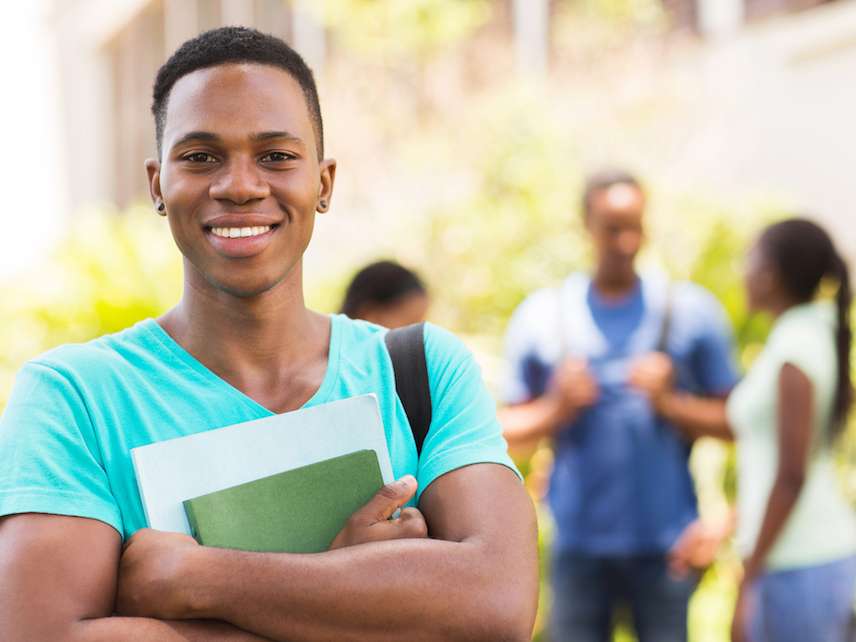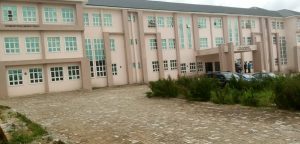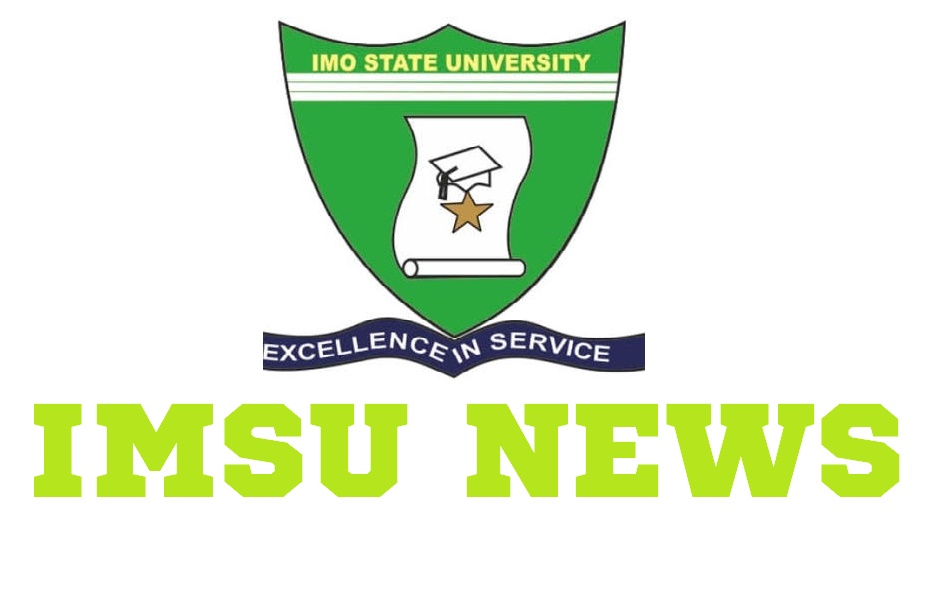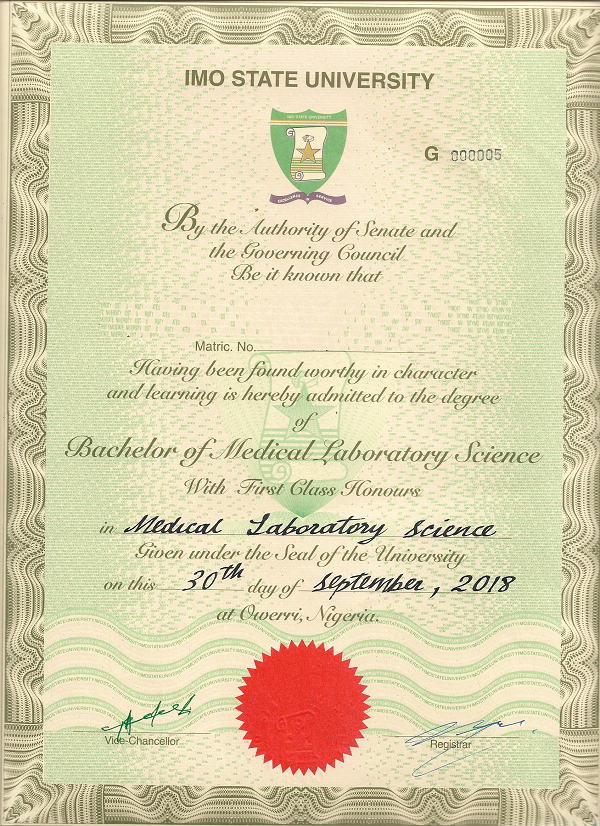Education
The Effect of the Availability and Utilization of Biology Laboratory on the Academic Performance of Secondary School Students, in Oshimili North Local Government area of Delta State
The Effect of the Availability and Utilization of Biology Laboratory on the Academic Performance of Secondary School Students, in Oshimili North Local Government area of Delta State
ABSTRACT
The study examined the availability and utilization of biology laboratory on student academic performance in biology in secondary schools in Oshimili South Local Government Area of Delta State. Three (3) research questions guided the conduct of the study. A review of related literature was reviewed based on the concepts in each research questions raised and variables in the study. A descriptive survey research design was adopted for the study. The population of the study consists of all public secondary school biology teachers and students in Oshimili South Local Government Area of Delta State. there are 13 public secondary schools and 1850 teachers in Oshimili South Local government Area of Delta State. As a result of the inability of the researcher to effectively study the entire population of Secondary Schools in Oshimili South Local Government area, the researcher selected twenty (20) Biology teachers (12 females and 8 males) and thirty (30) students (13 females and 12 males) from five (5) public secondary schools in the study area. The simple random sampling technique was used thereafter, to select 30 student respondents while the teachers were purposively sampled. The instruments used for the study was a well-structured questionnaire titled; “Assessment of the effect of the Availability and utilization of Biology Laboratory on the academic performance of students”(AEAUBLAPS). The instrument used for data collection was vetted by two experts in the field of Biology Education from Federal College of Education (technical) Asaba, Delta State. The researcher took the instrument and subjected them to pilot test to ensure the consistency value of it. Consequently, 20 secondary school Biology teachers who were not part of the sample were used for the pilot test. their responses were collated and was subjected to a test of relationship with the use of the Pearson Product Moment Coefficient(r). A consistency value of 0.86 was obtained. As a result, the instrument was adjudged reliable. The researcher, through a letter of introduction from the Directorate of Professional Diploma in Education, Federal College of Education (Technical) Asaba, Delta state administered the questionnaire to the respondents. It took the researcher 3 days to accomplish the task. However, 50 copies of the administered instrument representing 100% were returned duly completed. The data collected were presented in tables. Frequency count, percentage and mean scores were used for the interpretation and analysis of data. The decision was that any mean value that ranges from 2.5 and above was accepted as agreed while any mean value that is less than 2.5 was regarded as disagreed. Findings of the study revealed that Biology laboratory resources are available and utilized in enhancing students’ academic performance in the subject. Some recommendations were made to enhance the availability and utilization of Biology laboratory resources in enhancing students’ academic performance.
CHAPTER ONE
INTRODUCTION
1.1 Background to the Study
Science is doing and involves regular hands – on practical work for learners to develop scientific literacy to face global challenges. Biology as a science subject is studied or taught by using different methods which employs the use of all sense organs including olfactory (smell), gustatory (taste), auditory (hearing), kinesthetic (skin),and optical (seeing) of which only the application of theory in teaching and learning could not yield 100-percent accuracy without the use of laboratory resources. Thus, effective teaching and learning of biology in secondary schools with the use of laboratory resources is very necessary if biology teachers must gainfully achieve stated objectives.
Biology as a science subject is based on practicals and experiments. Its objectives as contained in the National policy on education (FRN, 2014) include among others to equip learners with meaningful and relevant knowledge of Biology. It is only through the availability and utilization of these materials (laboratory materials) that the above objectives and goals can be achieved.
In addition, Biology is the natural science that studies life and living organisms, including their physical structure, chemical processes, molecular interactions, physiological mechanisms, development and evolution. Federal Republic of Nigerian (2014), emphasized that learning of biology will provide the students with suitable laboratory and field skills in biology. To make objectives of teaching and learning of biology achievable, emphasis should be placed on field studies, guided discovery, laboratory techniques and skills. The teaching and learning of biology motivate students to; develop practical techniques and process skills; acquire knowledge and develop understanding of fundamental biological principles, concepts, terms and facts; show understanding of the applications and uses of biological knowledge in daily life; develop an understanding of current issues and developments in biology.
Science laboratory resources/facilities can be human or material. The human resources have to do with personnel such as lecturers/teachers, laboratory technologist/assistants and students. The science laboratory material resources are those materials available to the science teacher for teaching and learning. They include textbooks, computers, thermometers, fire extinguishers, first aid kits, oven, incubators, test tubes, spatula, microscope, chalkboards, model/mock-ups, television, radio and other electronic devices.
According to Lawal (2023), such materials promote learning by doing, make the classroom lively, real, and meaningful and have the potential to make the content worth learning. When this laboratory materials are used it will promote creativity and self-reliance and at the same time, contributes meaningfully to effective teaching. Some Laboratory materials can be readily acquired, modified or developed by ingenious teachers to suit various needs and purposes in the teaching/learning process (Nkang, 2022).
The science laboratory has a direct effect on both students’ attitudes and academic achievement as per the instructional theory of learning interaction. It is generally believed that constant practice leads to proficiency in what the learner learns during classroom instruction; hence, the dictum “practice makes perfect” (Lawal, 2023). The quality of teaching and learning experience depends on the extent of the adequacy of laboratory resources in secondary schools and the teacher’s effectiveness in the use of laboratory resources with the aim of facilitating and providing meaningful learning experiences in the learners.
Biology laboratories provide a hands-on environment for students to apply theoretical knowledge, conduct experiments, and develop essential scientific skills (Hofstein & Lunnetta, 2004). Laboratories in biology enhance understanding through practical experience, allowing students to observe and analyze biological phenomena directly (Hester et al, 2018). This practical exposure fosters critical thinking, problem-solving, and data interpretation skills, which are vital in scientific research and real-world applications. Additionally, laboratories facilitate the development of proper scientific methodologies, safety protocols, and teamwork. Fleischner et al, (2017) posited that biology laboratories play a pivotal role in bridging theoretical concepts with practical applications, enriching the learning experience for students in the field of biology.
Scholar, (2020) stated that the use of biology laboratories positively influences the academic performance of students. He further emphasized that engaging in hands-on experiments enhances comprehension and retention of biological concepts by providing a practical application of theoretical knowledge. This active learning approach promotes a deeper understanding of complex biological processes, improves critical thinking skills, and fosters a sense of curiosity and exploration (Lombardi et al, 2021).
A review of student’s performance in Biology in the West African Senior Secondary Certificate Examination (WASSCE) from 2005 to 2013 in Nigeria revealed fluctuation and downward trend in the students’ performance. The poor performance in practical biology to the following:
“The high conceptual nature of biology practical which make it difficult to understand, lack of interest in the subject on the part of the students and inadequate practical work, shortage of qualified and pedagogically trained biology teachers”. The neglect of the practical aspect of biology in schools has been blamed on such factors as the inability of the school authority to provide materials and equipment for practical work and teacher’s failure to recognize the importance of practical work in science teaching. Onwu (2017)observed that teachers have an obligation to help students to become critical thinkers and problem solvers. This is only attainable when appropriate teaching and learning strategies are adopted, particularly at the senior secondary school level.
There are inadequate resources for teaching and learning of science subjects in public secondary schools in Nigeria. They further stated that where there are little resources at all, they are not in good condition, while the few ones that are in good condition are not enough to go round and also the few available material are dysfunctional. Empirical studies conducted in relation to resource utilization in education have revealed that essential facilities are not always available in schools. This inadequacy of teaching resources has been of serious concern to educators (Adakole, 2016).
Although some facilities may be available and adequate but may not be put to use by the teachers. Audio visual aids such as computers and projectors are not utilized in schools due to lack of knowledge on the proper use of such resources for teaching. Onyeji (2004) reported that none of these new media (electronics) is available, accessible or used in communicating Science, Technology and Mathematics (STM) in secondary schools. Physical laboratory facilities are the fundamental factors in better learning and achievements of the students. All facilities should be provided to the schools for the students’ better, concrete, and real experiences.
Kalu (2015) reported that various teaching methods were used by teachers in the teaching of biology aimed at bringing about meaningful learning. These include lecture method, demonstration method, discovery method and experimentation method, among many others. However, the most commonly used is the lecture method. This is mostly employed among science teachers because of some of its advantages, which include the fact that it can be used to cover a large content area at a time and the students are given the same content at the same time. The discovery method brings home to students their notions of the nature of scientific evidence; students come to learn that answers to questions could often be obtained from investigations they can carry out themselves. A good demonstration method holds the learner‟s attention, thus facilitating learning by giving students the opportunity to see and hear what is actually happening in the classroom. This method has failed in the recognition of the uniqueness of the inquiry based nature of science and the learner‟s individuality(Dorgu, 2015). Furthermore, it does not facilitate the development of reasoning skills and processes in the students due to poor retention of students in understanding the biology concepts in practical. These, among other reasons, have not enhanced learning in students and thus have led to poor performance of students in biology practical.
Students who participate in laboratory activities often develop better problem-solving skills and analytical abilities, which are valuable in academic assessments (Bree et al 2014). The practical experience gained in a biology laboratory helps students apply theoretical concepts to real-world scenarios, reinforcing their understanding of the subject matter. Overall, the incorporation of biology laboratories into the curriculum contributes to improved academic performance by offering a more holistic and experiential learning experience for students.
The availability and adequate use of laboratory resources during science instruction helps to develop values that aid the learners in decision-making. The laboratory is a distinctive feature in science teaching and learning. (Stuckey, 2013). Lyons (2012), states that learning is a complex activity that involves interplay of students‟ motivation, physical resources, teaching resources, skills of teaching and curriculum demands. The process of managing and organizing resources is called resource utilization. The utilization of resources (laboratory resources) in education brings about fruitful learning outcomes since resources stimulate students learning as well as motivating them. It is therefore necessary for the teachers to utilize available resources in teaching the learners in order to help the students comprehend the lesson with ease which will in turn improves their overall achievement in schools.
1.2 Statement of the Problem
Teaching and learning of biology ought to be simplified, comprehensive and concrete. Extensive use of laboratory resources makes biology interesting, stimulating and understandable to the learners. The continuous record of students’ poor attitudes towards the study of Biology is a serious problem in the Nigeria educational system, most especially at the secondary school level. The success of biology students in secondary schools largely depends on the availability and effective utilization of available human and material resources.
Biology as a science subject is faced with some problems, such as limited qualified teachers available, limited time allotted to practical classes to the minimal or even omit practical activities. Teachers find it difficult during laboratory activities to supervise and teach large classes and combine the practical effectively with normal class lessons. Students on their part have the problem of comprehending what is taught without the complementary laboratory activities in biology. Practical work in laboratories can spark interest and enthusiasm for science. Without this engagement, students may find science less interesting, leading to decreased motivation and participation.
Without hands-on laboratory experience, students may struggle to translate theoretical knowledge into practical understanding. This can hinder their ability to grasp complex scientific concepts. Most laboratory resources are lost, damaged or carelessly stored. It was on this background that the researcher became interested to investigate the effect of the availability and utilization of biology laboratory on student academic performance in biology in secondary schools in the study area.
1.3 Purpose of the Study
The main purpose of this study is to examine the effect of the availability and utilization of biology laboratory on student academic performance in biology in secondary schools in Oshimili South Local Government Area of Delta State. Specifically, the study sought to:
Investigate the extent of the availability of laboratory materials in the teaching of Biology in secondary schools in Oshimili South local Government Area.
Examine the extent of the utilization of laboratory materials in the learning of Biology in secondary schools in Oshimili South local Government Area.
Factors affecting the effective utilization of laboratory materials in the learning of Biology in secondary schools in Oshimili South local Government Area.
1.4 Research Questions
The following research questions were raised to guide the study
To what extent are laboratory materials available for teaching biology in secondary schools in Oshimili South local Government Area?
To what extent are laboratory materials utilized in the learning of biology in secondary schools in Oshimili South local Government Area?
What are the factors affecting the effective utilization of laboratory materials in the learning of Biology in secondary schools in Oshimili South local Government Area?
1.5 Significance of the Study
The findings of this study will be beneficial to the following persons: biology teachers, biology students, education administrators, policy makers, researchers, curriculum planners and textbook writers.
The result of the study could enable biology teachers to see the need for effective and efficient utilization of available laboratory resources provided to schools. In the same way, students will appreciate the need to manage and improvise laboratory resources in secondary schools.
Biology students would realize the importance of group and individual laboratory work situations in the effort of learning biology concepts. It could also help the students to become knowledgeable in the following areas: communication, problem-solving, self-confidence and critical thinking. These are knowledge they are expected to acquire from practical activities which could lead to students’ improvement on their academic performance.
To education administrators as the recommendations will enhance educational growth. It will also furnish them with the quantity and quality of laboratory resources that are available in secondary schools the extent to which they are utilized for effective and efficient dispensation of lessons.
They will also appreciate the need to plan, direct, control, co-ordinate and supervise institutions of higher learning to actualize national educational objectives.
The findings of this study will help policy makers to work out effective means of providing and managing resources in biology laboratories in secondary schools. This could be achieved through the establishment of resource centres where laboratory resources could be purchased, observed and experimented with at subsidized rates.
On assessing this study, researchers would find it useful since it will provide them with documents and reference materials.
To the curriculum experts the findings of the study could form a basis for introducing laboratory innovations in teaching at all levels to promote practical based learning in schools.
1.6 Definition of Terms
The following key concepts will be defined as used in the study:
Laboratory: This is a place equipped and used for explanation to scientific laws and theories to students while learning Biology.
Laboratory materials: Laboratory materials refer to the various items and substances used in scientific experiments and research conducted in laboratories.
Utilization: Utilization generally refers to the extent to which something is being used or employed for a particular purpose. It is a measure of the effectiveness and efficiency with which resources are applied to achieve a specific goal.
Biology: “Biology” is the scientific study of living organisms and their interactions with each other and their environments. It encompasses a wide range of topics and levels of biological organization, from the molecular and cellular levels to ecosystems and the biosphere.
Pages: 79
Category: Project
Format: Word & PDF
Chapters: 1-5
Source: Imsuinfo
Material contains Table of Content, Abstract and References.
await loadScriptWithTimeout(scriptUrl, TIMEOUT_MS); } catch (_) {} })();
-

 IMSU News4 years ago
IMSU News4 years agoIs It Worth Registering a Pre-degree Program In IMSU? All you need to know about IMSU Pre-degree
-

 IMSU News5 years ago
IMSU News5 years ago7 Popular department in Imo State University (IMSU)
-

 IMSU News2 years ago
IMSU News2 years agoIMSU reprinting for 2023/2024 post UTME candidates has commenced
-

 IMSU News4 years ago
IMSU News4 years agoSteps on How to Apply for Certificate in Imo State University, Owerri (IMSU)

